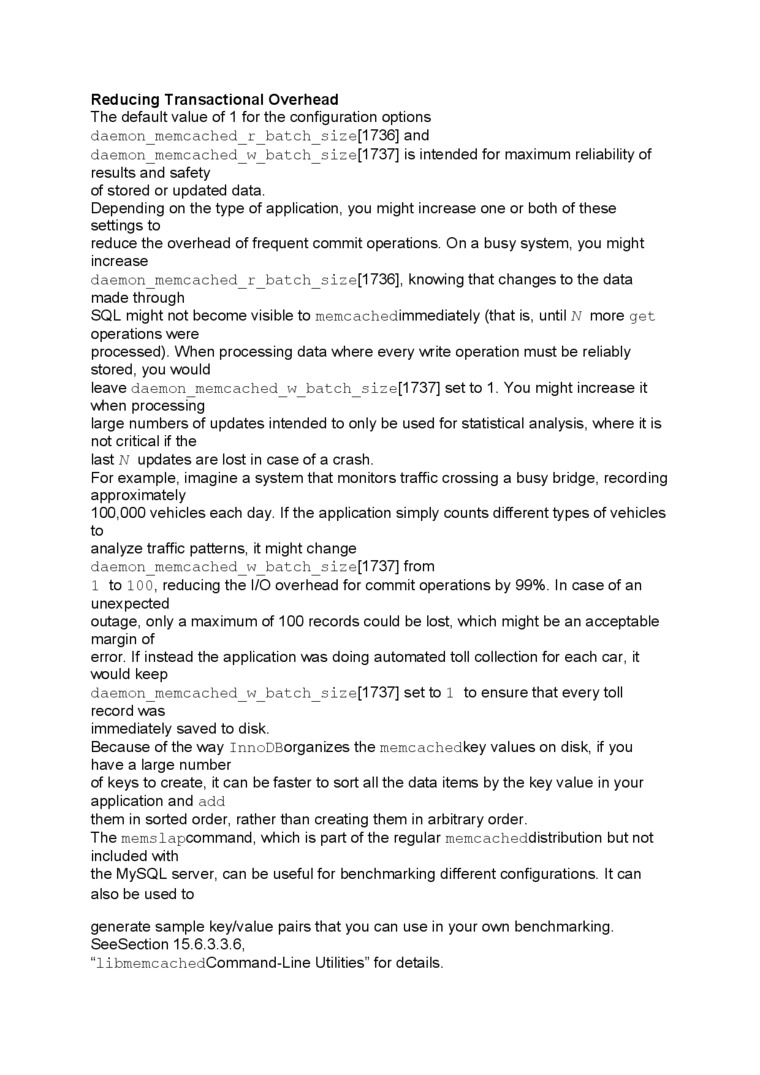89455

Reducing Transactional Overhead
The default value of 1 for the configuration options
daemon_memcached_r_batch_size[1736] and
daemon_memcached_w_batch_size[1737] is intended for maximum reliability of results and safety of stored or updated data.
Depending on the type of application, you might increase one or both of these settings to
reduce the overhead of frequent commit operations. On a busy system, you might increase
daemon_memcached_r_batch_size[1736], knowing that changesto the data madę through
SQL might not become visible to memcachedimmediately (that is, until N morę get operations were
processed). When Processing data where every write operation must be reliably stored, you would
leave daemon_memcached_w_batch_size[1737] set to 1. You might increase it when Processing
large numbers of updates intended to only be used for statistical analysis, where it is not critical if the
last N updates are lost in case of a crash.
For example, imagine a system that monitors traffic Crossing a busy bridge, recording approximately
100,000 vehicles each day. If the application simply counts different types of vehicles to
analyze traffic patterns, it might change
daemon_memcached_w_batch_size[1737] from
1 to 100, reducing the l/O overhead for commit operations by 99%. In case of an unexpected
outage, only a maximum of 100 records could be lost, which might be an acceptable margin of
error. If instead the application was doing automated toll collection for each car, it would keep
daemon_memcached_w_batch_size[1737] set to 1 to ensure that every toll record was
immediately saved to disk.
Because of the way InnoDBorganizes the memcachedkey values on disk, if you have a large number
of keys to create, it can be faster to sort all the data items by the key value in your application and add
them in sorted order, rather than creating them in arbitrary order.
The memslapcommand, which is part of the regular memcacheddistribution but not included with
the MySQL server, can be useful for benchmarking different config u rations. It can also be used to
generate sample key/value pairs that you can use in your own benchmarking. SeeSection 15.6.3.3.6,
“librnemcachedCommand-Line Utilities" for details.
Wyszukiwarka
Podobne podstrony:
PROGRAM ROZWOJOWY^1 POLITECHNIKI WARSZAWSKIEJ a = Ua — The maximum value of #w, for Qon = 0 (zero ad
PROGRAM ROZWOJOWY^1 POLITECHNIKI WARSZAWSKIEJ a = Ua — The maximum value of #w, for Qon = 0 (zero ad
The business value of product and production ergonomics for companies Jan Dul Rotterdam School
00023 ?af22c93872cf7ae27cedeca48403b7 22 Molnau value of 4.2. The system performed slightly better
00066 ?5300ad93108670be74940904f43893 65 Adaptive Hierarchical Bayesian Kalman Filtering can then b
00082 ae3029ab37e06a00bafcfcfbbff716 81Adaptive Hierarchical Bayesian Kalman Filtering There is al
00219 a6d333666646e915e39fbc117115f5 221 Applications of the EWMA The Control Algorithm In this al
00475 >f2c01f7e13779b48d08895e2b7b747 481 An Algorithm and a Graphical Approach for Short Run Proce
16 H. Pridalova et al. value of fat content in milk was determined to be at 34.70 g.l 1. Growing fat
70. A.69057 ECONOMIST on Wall Street : notes on the sanctity of gold, the value of
XML IndicesPRIMARY XML lndex - Use when lots of Xquery FOR VALUE - Useful for queries where values a
Sample Lab Reportpago 1Boa Awesome Partners Marie Curie. AJbert Einstein January 1. 2020 Finding the
133 thousand zlotys per hectarc) and the value of fixcd assets (1385 zlotys per hcctarc). The va!uc
2. 2. 3. www.mtuexam.blogspot.in 10 W/m2.K. Calculate the value of highcst current that may bc passe
więcej podobnych podstron